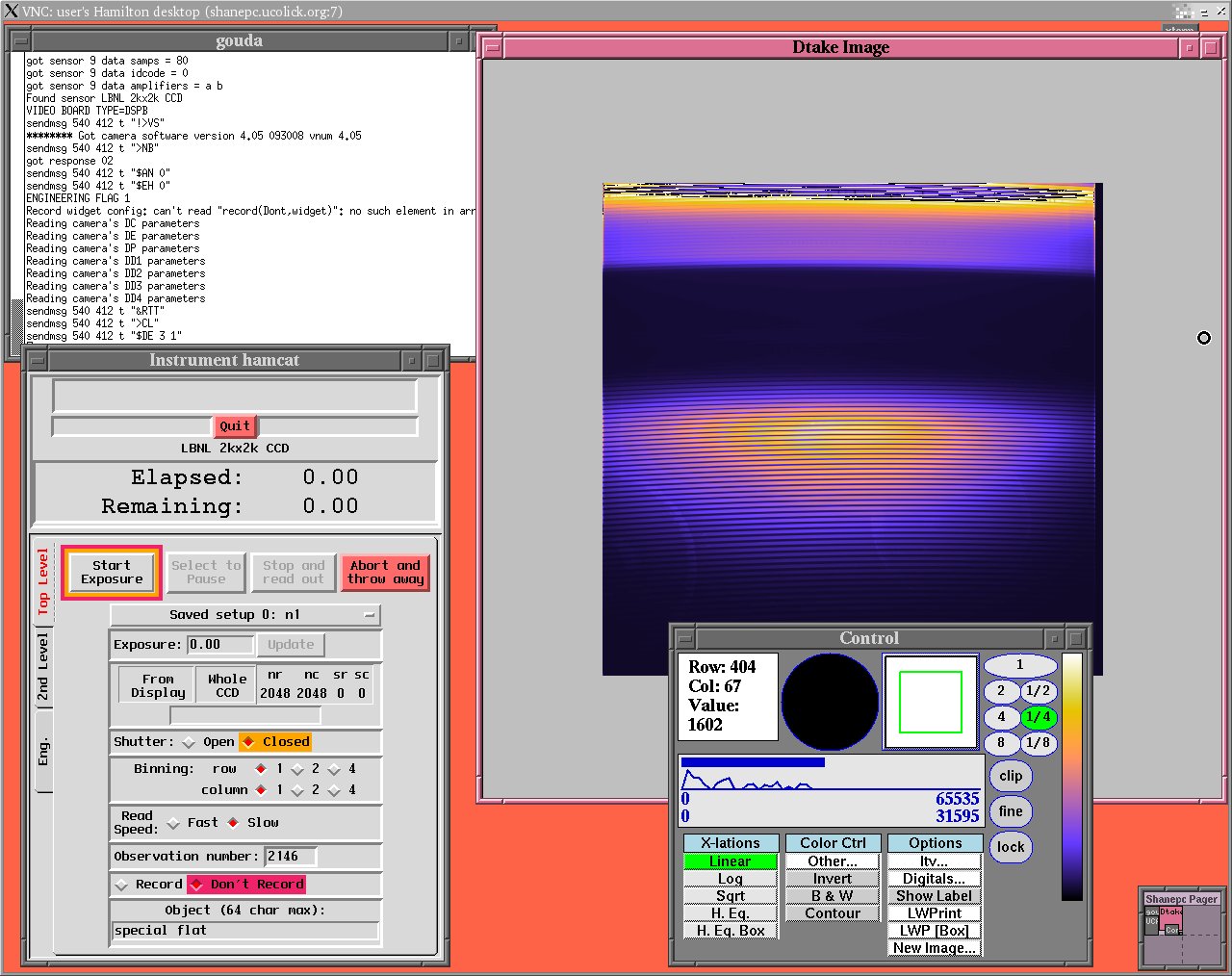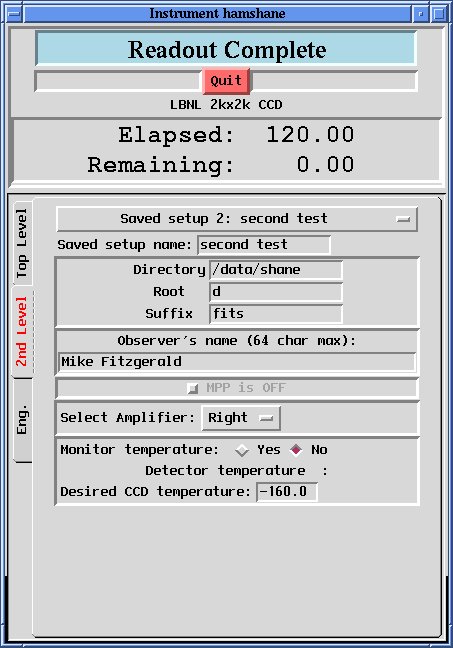Data Taking System
| The data taking system (DTS) runs on dusty. Observers do not log into this computer directly, but rather use the commands ham_start shane or ham_start cat to start the DTS for the Shane or CAT telescopes, respectively, from the user account on gouda or catpc. The data taker automatically detects whether dewar #4, #6, or dewar #8 is installed on the Hamilton Spectrograph. Dewar #4 is currently the default detector and dewars #6 and #8 have been retired from use. A sample DTS screen is shown in Figure 1. The data taker consists of three main windows: the Instrument Control GUI, XVideo Image Display, and XVideo Control. The Instrument Control GUI has three levels reached by tabs along its left margin. The user will be concerned primarily with the top level in the course of observing. The 2nd level controls a few parameters that usually need only be set once at the beginning of the night. The 3rd level is for engineering. It is not intended for the use of observers and is not described here. The XVideo image display software is described elsewhere. |

Figure 1: Data Taking System |
CCD Control Window: Top Level
 Click for a full-sized image.
Click for a full-sized image.
|
The top level of the GUI allows one to set various detector parameters
in advance, and to control exposures. Parameters are briefly described
here. Commands for controlling exposures -- start, pause, stop, and
abort -- are self explanatory.
Saved Setup Parameters are stored as one of ten
"saved setups." Current parameters automatically become whichever
saved setup is selected at the time. Saved setups may be named on the
2nd level. Exposure time Zero-second exposures and fractional seconds are allowed. Note that for short exposures shutter fly time errors can become significant. The "Update" button allows one to change the exposure time of the exposure in progress. E.g. you start a 1200s exposure, but if you decide more exposure time is necessary, you may enter the new total exposure time and press "Update". You may also choose to do a shorter exposure this way as long as the new exposure time is longer than the current elapsed exposure time. When there is no exposure in progress the "Update" button will be greyed out and unusable. CCD Window This is the amount of the CCD which is actually read out. Smaller windows read out more quickly. The window size may be defined graphically from the image display, or by entering the number of rows, number of columns, and origin of the readout region. To define a window from the image display, type "b" in the image display window, then use the mouse to click on the first corner of the box, then click again on the opposite corner of the desired region. Once the desired region is selected, click on the "From Display" button. To readout the entire CCD, click the "Whole CCD" button. Note, there is currently a bug in the image display software includes the overscan region as part of the image when defining a region from a box drawn on the display. Thus, your region will be off by 32 columns, the width of the overscan region. We hope to fix this problem in the near future. Shutter Open for normal exposures, closed for darks and bias frames. If the shutter will be closed for a dark exposure, the Closed label will be highlighted orange and an orange border will be on the Expose button. Binning The Hamilton is generally used binned 1x1 for normal observations. However, each axis may be independently binned by 1, 2, or 4 as data acquisition requires. Read Speed Fast is about half the time of slow for dewar #8, gained at the price of increased readnoise (see CCD Characteristics). Observation Number and Recording The observation number increments with each recorded exposure. It can be set manually, but be careful, it is possible to overwrite existing data by setting the number back. Note that the last unrecorded exposure is saved in /scratch/hamcat/scr.fits or /scratch/hamshane/scr.fits, for the CAT or Shane telescopes, respectively. More on recording images in "2nd Level," below. When set to "Don't Record", the Don't Record label will be highlighted red and a red border will appear around the "Expose" button as a warning. Object The string entered will appear as the OBJECT card in the image's FITS header. | |
|---|---|---|
CCD Control Window: 2nd Level
 Click for a full-sized image.
Click for a full-sized image.
|
The 2nd level GUI presents parameters that are usually only set once
in the course of a night, if at all. Only a few of these are for
observer use. MPP and Amplifier selection should remain as set by
default, unless there is a clearly understood reason to change them.
Saved Setup name This allows a name to be associated with a
saved setup (see Top Level). Record count Whether an image is recorded or not is controlled from the Top Level by turning recording on or off. The "record count" parameter is generally set to "1" or "-1" so that all images are saved whenever recording is turned on. Directory This parameter should be set to "/data/shane" or "/data/cat" for the Shane or CAT telescopes, respectively, so that recorded images are saved in the proper /data subdirectory on dusty. The data paths from the user computers in the control rooms are /data/hamshane/ and /data/hamcat/. Please do not change this parameter, it is important to save them there so that they will be found and saved in our on-line data archive, http://mthamilton.ucolick.org/data/. Data become available in the archive shortly after being acquired. If you need to set or reset your data archive password, please contact a Support Astronomer. If data from a previous observer's run is in the data directory, contact a Support Astronomer or Telescope Technician so they can check that the data were properly archived before clearing the directory. Root The string entered here becomes the root of the image file names, prepended to a unique image number. E.g., using the parameters shown here, the first recorded image will become /data/hamshane/d1.fits, the second d2.fits, and so on. The root can be whatever you wish, but we recommend that you use the default "d". Suffix You may choose the suffix to be appended to your image file names, but it must be one recognized by our automatic archiver: fits, ccd, fts, spr, or sdt. We prefer that you use fits as the suffix for Hamilton data. Observer's name You may enter any number of first or last names up to a total of 64 characters. White space and comma separation are permitted. The string will appear in the "OBSERVER" field of the FITS header. | |
Support Astronomers (sa@ucolick.org) Last modified: Thu Jan 19 11:47:43 PST 2012